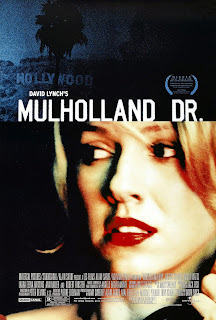Tuesday, May 6, 2014
MULHOLLAND DR.
(October 2001, U.S.)
Over the years, I've started to wonder if we're ever going to see David Lynch in (mainstream) art cinema again. His last film INLAND EMPIRE was in 2007 and since then he's been seen on the internet mostly. While my brain ponders this question, I can't help but hold onto his collection of work for dear life. Should there not be any more David Lynch films, treasures like BLUE VELVET (1986), TWIN PEAKS and WILD AT HEART (both 1990) and MULHOLLAND DR. shall become all the more valid for those who truly appreciate cinema as art. And as is the case with much of the world's art, the ability to both understand and appreciate it is solely dependent on the viewer.
As a neo-noir film, the story of MULHOLLAND DR. (at least on the surface) is of an aspiring actress named Betty Elms (played by Naomi Watts), newly arrived in Los Angeles, California who meets and befriends a recent amnesiac woman (played by Laura Harring) hiding in an apartment that belongs to Betty's aunt. As with any Lynch story, it also includes several other seemingly unrelated vignettes that eventually connect in various ways, as well as surreal scenes and images that relate to the film's cryptic narrative. The film is hugely atmospheric with the flavor of Los Angeles, it's massive city lights and the dark unknowns of it's quiet suburban streets. Yes, L.A. may be considered a city of dreams, but through Lynch's eyes, it's also quite a living nightmare.
The character of Betty can perhaps be best described as a picture postcard of Hollywood innocence in the classic tradition of someone like Grace Kelly in an Alfred Hitchcock film. She's beautiful, naïve and filled with a rather heart-melting sunny disposition. Behind the cuteness, however, is a girl who not only longs for Hollywood stardom (and would perhaps sleep with anyone who could help her obtain it), but also appears to enjoy diving into a good, real life mystery. As previously mentioned, her new friend who calls herself Rita suffers from amnesia, a result of a horrible car accident we see at the beginning of the film, and Betty's sweet nature can't help but try to help her (Rita) discover the mystery of her identity. Rita also happens to have in her possession a large amount of cash and a mysterious blue box that comes with a matching key. What is the box for and what will happen when it's opened? With Lynch, we can only guess!
One thing we don't have to guess and that's Betty and Rita make hot looking lovers! Admittedly, sex is not the first thing I think of when I consider the films of David Lynch, but the man does managed to put together some steamy sequences...
The average David Lynch viewer is meant to muddle along with the basic outlines of any story while concentrating more on the deeper, alternate meanings and realities that are not as obvious. Who is Betty, really? Is she really Betty? Somewhere along the way, we're meant to believe that she may possess an alternate existence in the name of Diane Selwyn. Is Rita connected to that existence or does she just happen to be along for the wild ride? Believe it or not, for the true "Lynchian", the questions can often be more fun than the potential answers. And yet, despite the deep mystery of it all, there are moments when the obvious shines through. Later in the film, when the blue box is finally opened, it falls to the floor and we are instantly seeing this particular world of L.A. we've been invited to in a different setting. From the moment the mysterious cowboy opens the bedroom doors and says to the woman in the bed, "Hey, pretty girl. Time to wake up.", we know things are about to change. Diane Selwyn (also played by Watts) wakes up and looks exactly like Betty but is portrayed instead as a failed actress driven into a deep depression by her unrequited love for a woman named Camilla Rhodes (also played by Harring). It would seem our once sunny, innocent Grace Kelly-type is now an angry and vengeful lesbian who wants her ex-lover dead! By the end of the film, Diane is terrorized by hallucinations of an elderly couple and runs screaming to her bed, where she fatally shoots herself. To this day, despite my best efforts, I still have no idea what the climax of the elderly couple is supposed to represent.
Now, as with most films of David Lynch, one cannot avoid diving into words like meaning, symbolism, interpretation and even subconscious. One particularly valid interpretation of the film uses an analysis to explain that the first part is a dream of the real Diane Selwyn, who has cast her dream-self as the innocent and hopeful "Betty", reconstructing her history and persona into something like an old, classic Hollywood movie. In the dream, Betty is successful, charming, and lives the fantasy life of the soon-to-be-famous actress. The last part of the film presents Diane's real life as terribly bleak, in which she's failed both professionally and personally. She arranges for her cold ex-lover, to be killed, and unable to cope with the guilt, re-imagines her as the pliable and dependent amnesiac named Rita. In an alternate interpretation, Betty and Rita and Diane and Camilla may exist in parallel universes that sometimes interconnect with each other. Or perhaps the entire film is a dream, but whose dream is it? Repeated references to beds, bedrooms and sleeping can perhaps symbolize the heavy influence of those dreams. Note that Rita falls asleep several times after her accident. In between the film's episodes, disconnected scenes such as two men having a conversation at a coffee shop, Betty's arrival in Los Angeles and the bungling actions of the hit man take place, suggesting that Rita may actually be dreaming them all. After Diane shoots herself, the bed is consumed with smoke and Betty and Rita are shown beaming at each other, after which a woman in the club balcony whispers "Silencio" as the screen fades to black. These concluding images float in an indeterminate zone between fantasy and reality, which is perhaps the genuine metaphysical dimension of the cinematic image David Lynch is always trying to express. But like any true piece of art, there may be no correct interpretation and such conclusions are best left to the individual interpreter. For myself, I tend to go with the first example I gave at the start of this paragraph. It's what makes sense to me!
Favorite line or dialogue:
Cowboy: "A man's attitude...a man's attitude goes some ways. The way his life will be. Is that somethin' you agree with?"
Adam Kesher: "Sure."
Cowboy: "Now...did you answer 'cause you thought that's what I wanted to hear, or did you think about what I said and answer cause you truly believe that to be right?"
Adam: "I agree with what you said, truthfully."
Cowboy: "What'd I say?"
Subscribe to:
Post Comments (Atom)




No comments:
Post a Comment